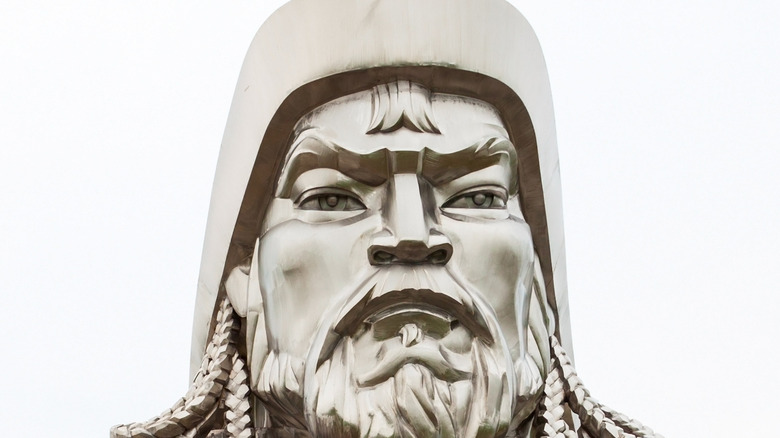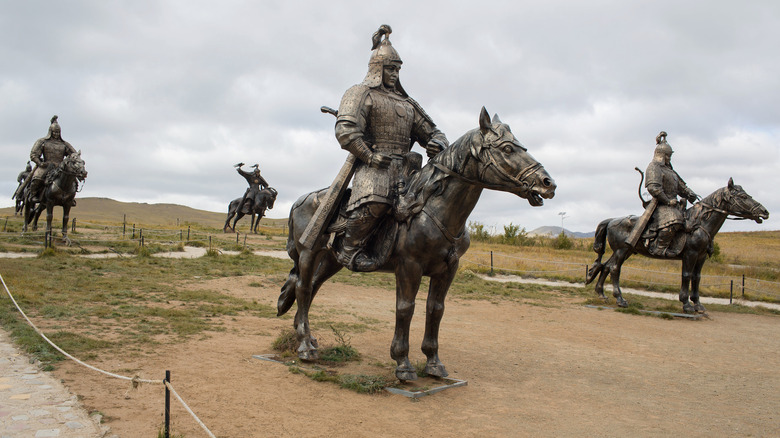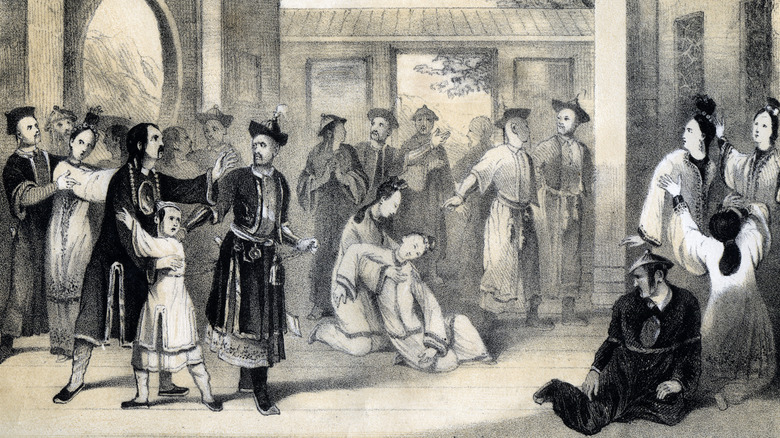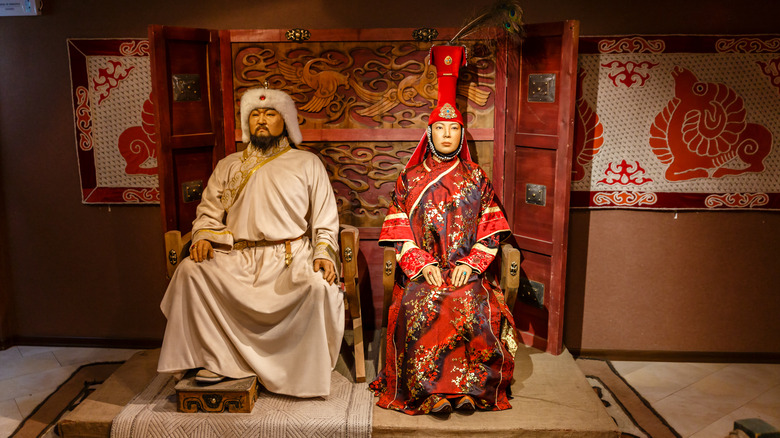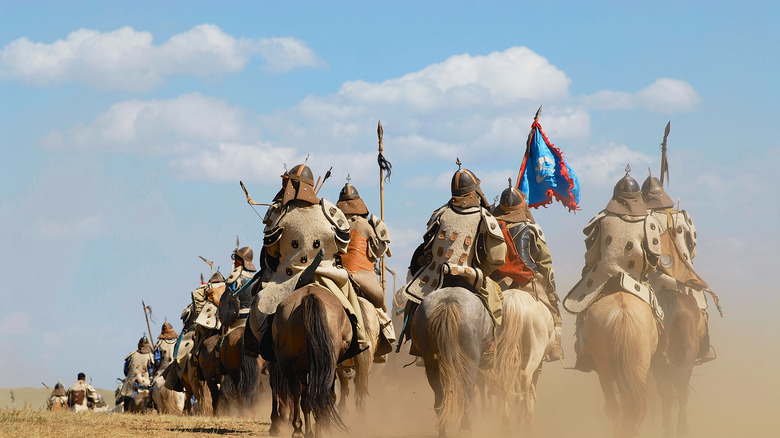How Genghis Khan Was Even More Evil Than You Think
Genghis Khan, whose birth name was Temüjin, was born in Mongolia. The likely year of his birth was 1162, though sources aren't completely sure of the date. He would eventually become known as one of the bloodiest warriors of all time and the first Great Khan ("universal ruler") of the Mongol Empire, according to How Stuff Works.
His childhood wasn't much of a fun time. His father, a Mongol chief called Yesügei, was assassinated when Genghis Khan was 9 years old. At this time, he and his mother (who had been kidnapped by his father from another tribe and forced into marriage) were cast out of the village and forced to survive by foraging for food. While the young Genghis Khan is often described as weakly and scared, he was also charming, and as he got older, he used his charisma to gain allies and attract supporters.
Genghis Khan's ability to build alliances allowed him to unite many of the nomadic tribes of Northeast Asia and build a powerful army. Once he had that, he embarked in a series of campaigns and invasions to take over Central Asia and China, present-day Iran, Turkmenistan, Uzbekistan, and Afghanistan (via History).
His war tactics were simple. According to History, he never left an enemy leader alive as he advanced to gain more territory. This served a double purpose: There was no need to worry about being stabbed in the back later, and it helped cement his image as ruthless.
He killed as many as 40 million people
The Mongol conquests are considered one of the deadliest, bloodiest armed conflicts in the history of civilization. When the Mongol army attacked villages, they usually killed most of the people in it. How many died during Genghis Khan times is hard to know exactly, though some historians estimate the numbers to be over 40 million. In his book "Genghis Khan: Life, Death, and Resurrection," author John Man explains that in the early 13th century, the Jin Dynasty recorded 7.6 million households in Northern China. When the Mongol conquered China in 1234 and conducted their first census, they recorded just 1.7 million households. Man points out the reduction could account for a decline in population from as much as 60 million to as little as 10 million (as quoted in Necrometrics).
Even individual attacks resulted in a staggering number of deaths. When invading Baghdad, the Mongols killed about 800,000 residents. When attacking the city of Merv, the number of estimated victims went up to 1.3 million. Author Stephen Pinker explains in his book, "The Better Angels of Our Nature," that city massacres were as brutal as they could be. People would be lined up outside the walls of the city to face the Mongol forces. Armed with a battleaxe, each soldier would then be given a number (10, 50, 100) of people they had to kill (via Bede Journal).
Did he kill 1.75 million people in a single hour?
Literally speaking, no single person can kill that many people in a single hour, so we have to assume that the tales mean he and his army killed that many at once. This, in theory, happened in April 1221, when Khan's army attacked the city of Nishapur, in what is modern-day Iran. It all started when Toquchar, one of Genghis Khan's sons-in-law, was killed with an arrow fired by a Nishapuran soldier after the city had originally surrendered and then revolted as Khan's army retreated (via How Stuff Works). Khan, who was infamous for his "one chance only to surrender" policy, probably didn't need a reason to kill everybody, but the story goes it was actually his daughter who requested the killing of everybody in the city (with a 1.75 million population) to avenge her husband's death. According to How Stuff Works, her request also included that the victims would be beheaded, and the skulls piled up in a pyramid.
According to Ata-Malik Juvaini, a Persian chronicler who wrote about the Nishapur destruction about 40 years after it happened, "The Mongols now descended from the walls and began to slay and plunder.... They then drove all the survivors, men and women, out onto the plain; and ... it was commanded that the town should be laid waste in such a manner that the site could be ploughed upon; and that ... not even cats and dogs should be left alive." (via The DBQ Project).
Genghis Khan discovered the power of psychological warfare
Genghis Khan used a very basic technique during his conquests: terror. He not only killed and destroyed, but he made sure there were always a few survivors to spread the word about what happened when you didn't surrender to the Mongol army. When Khan decided to kill the entire population of a conquered city, he really meant everybody. No men, women, children, or even animals were spared — except the few chosen ones to witness the horror, so they could talk about it. This was so effective that, according to World History, it eventually led to entire towns surrendering as soon as they knew the Mongols were approaching. As author and historian René Grousset points out in his book The Empire of the Steppes: A History of Central Asia, "the Mongols made the fullest use of the terror inspired by their physique, their ugliness, and their stench."
The Mongols rarely took prisoners, and they rarely used torture. Instead, they preferred to kill everybody as quickly and methodically as possible. When they did take prisoners, it was to use them as human shields, forcing them to march in front of the Mongol army, so they would be killed first as they approached a city. They made some exceptions to their "quick deaths rule" when it came to enemy rulers. Many suffered a much darker fate that included being choked to death by having stones pushed down their throats, trampled by horses, or suffocated (via FactsAndDetails.com).
The Mongols ate anything
The Mongol army was always on the move. By the early 1200s, Genghis Khan had over 100,000 soldiers under his command, and everywhere the army went, animals and families followed. In fact, because kumis (horse milk) was an important part of their diet, the Mongols brought hundreds of thousands of animals with them, including not only horses but also cattle and oxen. The wives and children of the soldiers followed behind as well (via Daily Mail). Being always on the move meant food wasn't always easy to obtain, so the Mongols made do by eating whatever meat they could get their hands on.
According to The New Yorker, this included everything from marmots to rats to dogs to wild hamsters. There are also reports of them running out of food during sieges and eating their own soldiers — though the reports don't say whether that meant they ate the recently deceased or they actually killed some of the soldiers for food. Other reports claim that during long expeditions and battles, where the army would face starvation, soldiers would resort to eating dead bodies found on the streets (via WAMC).
He might have helped spread the Black Plague
The Black Plague killed 25 million people in Europe and potentially another 25 million in Asia in a span of just five years starting in 1347, according to ZME Science. But the plague had been around for a lot longer than that, with outbreaks as early as the sixth century. In Asia, the bubonic plague spread along trade routes, which Genghis Khan helped establish through the creation of the Mongol Empire.
Recent studies into the death of Genghis Khan show that he might have died of the same disease he helped spread. For centuries, historians have offered many theories about how he died, including being shot with an infected arrow, dying of blood loss, getting killed during battle, and even falling from his horse. But looking into historical text, researchers found that the fever and symptoms described as being the cause of his death matched those appearing in people suffering from the bubonic plague rather than typhoid fever or other theories considered before. Without access to his remains (his burial place has never been located), it's impossible to prove (via Live Science).
The fact that he might have contracted the bubonic plague himself is a good argument that the Mongol armies might have carried and spread the disease as they moved through Asia. In the 14th century, the Mongols could have purposely spread the black plague by catapulting infected bodies into towns, according to research published via Montana State University.
